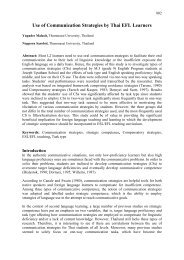The Effects of Semantic Mapping on Vocabulary Memorizing
The Effects of Semantic Mapping on Vocabulary Memorizing
The Effects of Semantic Mapping on Vocabulary Memorizing
You also want an ePaper? Increase the reach of your titles
YUMPU automatically turns print PDFs into web optimized ePapers that Google loves.
the particular occasi<strong>on</strong>. <str<strong>on</strong>g>The</str<strong>on</strong>g> most effective associate b<strong>on</strong>ds for producti<strong>on</strong>, therefore, c<strong>on</strong>nect the<br />
words with their meanings.<br />
3.3. Strategies to improve vocabulary retenti<strong>on</strong><br />
<strong>Vocabulary</strong> learning strategies are <strong>on</strong>e part <str<strong>on</strong>g>of</str<strong>on</strong>g> language learning strategies which in turn are part<br />
<str<strong>on</strong>g>of</str<strong>on</strong>g> general learning strategies (Nati<strong>on</strong>, 2001). Some vocabulary learning strategies such as<br />
metacognitive, cognitive, memory and activati<strong>on</strong> strategies are listed by Gu and Johns<strong>on</strong> (1996,<br />
cited in Ghazal, 2007, p.85-86):<br />
Metacognitive strategies c<strong>on</strong>sist <str<strong>on</strong>g>of</str<strong>on</strong>g> selective attenti<strong>on</strong> and self-initiati<strong>on</strong> strategies.<br />
Cognitive strategies entail guessing strategies, skillful use <str<strong>on</strong>g>of</str<strong>on</strong>g> dicti<strong>on</strong>aries and note-taking<br />
strategies. Memory strategies are classified into rehearsal and encoding categories. Word lists<br />
and repetiti<strong>on</strong> are instances <str<strong>on</strong>g>of</str<strong>on</strong>g> rehearsal strategies. Encoding strategies encompass such<br />
strategies as associati<strong>on</strong>, imagery, visual, auditory, semantic, and c<strong>on</strong>textual encoding as well<br />
as word-structure. Activati<strong>on</strong> strategies include those strategies through which the learners<br />
actually use new words in different c<strong>on</strong>texts.<br />
Encoding strategies are menti<strong>on</strong>ed in literature as vocabulary learning strategies that can enhance<br />
retenti<strong>on</strong> intervals <str<strong>on</strong>g>of</str<strong>on</strong>g> vocabulary (Gu &Johns<strong>on</strong>, cited in Segler et al. 2001). Encoding strategies<br />
include such strategies as associati<strong>on</strong>, imagery, visual, auditory, semantic, and c<strong>on</strong>textual<br />
encoding as well as word-structure (Ghazal, 2007). Memory <str<strong>on</strong>g>of</str<strong>on</strong>g> vocabulary can be enhanced<br />
when there is an associati<strong>on</strong> <str<strong>on</strong>g>of</str<strong>on</strong>g> new words and known <strong>on</strong>es sharing a similar part in spelling,<br />
sound or meaning. Employing images, semantic mapping or other graphic organizer techniques<br />
(Segler et al. 2001; Nati<strong>on</strong>, 2001 cited in Ghazal, 2007) is encouraged for better encoding which<br />
results in better retrieving later. One <str<strong>on</strong>g>of</str<strong>on</strong>g> implicati<strong>on</strong>s for classroom practice that Channell (1988)<br />
derived from her research is that learners should be encouraged to make their own lexical<br />
associati<strong>on</strong>s when they are learning vocabulary. With regard to word meaning and retrieval,<br />
many researchers (Hague, 1987; Cater, 1987; Amer, 2002) agreed that semantic mapping is<br />
effective for l<strong>on</strong>g-term memory and aids the recall. <str<strong>on</strong>g>The</str<strong>on</strong>g>refore, in this study, the researcher<br />
c<strong>on</strong>cerned about the semantic mapping technique which will be presented in the next secti<strong>on</strong>.<br />
4. <str<strong>on</strong>g>Semantic</str<strong>on</strong>g> mapping for vocabulary teaching<br />
4.1. Definiti<strong>on</strong>s <str<strong>on</strong>g>of</str<strong>on</strong>g> semantic mapping<br />
Developments in “lexical semantics” have prompted the development <str<strong>on</strong>g>of</str<strong>on</strong>g> the “semantic field<br />
theory”, “semantic networks” or “semantic grids” strategies which organize words in terms if<br />
interrelated lexical meanings. <str<strong>on</strong>g>The</str<strong>on</strong>g> “semantic field” theory suggests that the lexical c<strong>on</strong>tent <str<strong>on</strong>g>of</str<strong>on</strong>g> a<br />
language is best treated not as a “mere aggregati<strong>on</strong> <str<strong>on</strong>g>of</str<strong>on</strong>g> independent words” but as a collecti<strong>on</strong> <str<strong>on</strong>g>of</str<strong>on</strong>g><br />
interrelating networks or relati<strong>on</strong>s between words (Stubbs, cited in Amer, 2002). It is noteworthy<br />
that words may be grouped together (related to each other) according to different criteria.<br />
Animals, for example, may be grouped in terms <str<strong>on</strong>g>of</str<strong>on</strong>g> physical features; they may be grouped in<br />
terms <str<strong>on</strong>g>of</str<strong>on</strong>g> n<strong>on</strong>physical features such as pet, wild, food, etc. (Gairns and Redman, 1986).<br />
<str<strong>on</strong>g>Semantic</str<strong>on</strong>g> elaborati<strong>on</strong> c<strong>on</strong>sists <str<strong>on</strong>g>of</str<strong>on</strong>g> a series <str<strong>on</strong>g>of</str<strong>on</strong>g> techniques as semantic feature analysis, ordering,<br />
pictorial schemata and semantic mapping (Ellis, 1995; Sokmen, 1997). <str<strong>on</strong>g>Semantic</str<strong>on</strong>g> mapping and<br />
semantic feature analysis draw learners’ prior knowledge and use discussi<strong>on</strong> to elicit informati<strong>on</strong><br />
about word meanings. <str<strong>on</strong>g>Semantic</str<strong>on</strong>g> feature analysis is similar to semantic mapping, with the<br />
633






